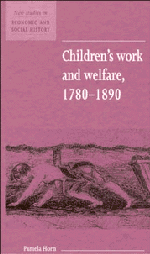Conclusion: the working-class child in the 1880s
Published online by Cambridge University Press: 04 August 2010
Summary
Partly as a result of the passage of labour and education legislation and partly through changing economic and social conditions, the century after 1780 saw a progressive lengthening of childhood as a stage in life. In the 1840s, 8 became established as the minimum age for half-time employment in textile mills and by the end of the 1860s that had been extended to a number of other important manufacturing processes as well as to cottage industries and public agricultural gangs. During the 1870s this minimum was raised to 10, while 13 was accepted as the age at which childhood officially ended. In addition, certain jobs were identified as unsuitable for children to carry out, and recognition was given to the fact that such youngsters lacked the intellectual and physical powers of adults when it came to bargaining over employment conditions. Children were accepted as ‘special’ cases who could be protected by legislation without infringing current laissez-faire philosophy.
In the late eighteenth century the childhood of the lower orders had been regarded largely as a time of preparation for the world of work. By the later nineteenth century it was being seen as a period in life which had its own ‘dynamics and culture’, as Cunningham puts it (Cunningham, 1991). This concept was applied to all social classes and geographical regions. Play and pleasure were accepted as important for the children of the poor as well as for those from more prosperous homes.
- Type
- Chapter
- Information
- Children's Work and Welfare 1780–1890 , pp. 69 - 71Publisher: Cambridge University PressPrint publication year: 1995



